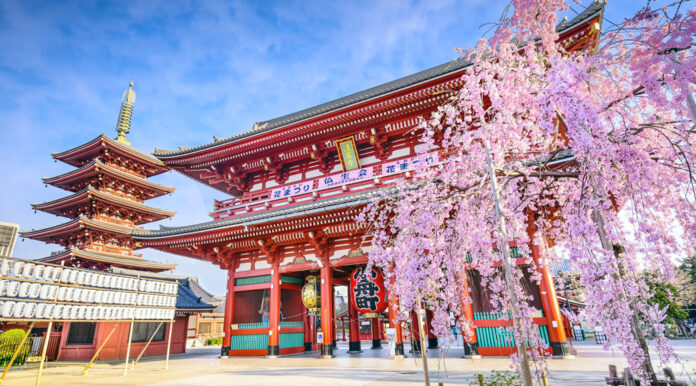Japan, a country rich in culture, history, and natural beauty, beckons travelers from around the world with its unique blend of ancient traditions and modern innovations. From bustling metropolises to serene landscapes, Japan offers a plethora of attractions that cater to every type of tourist. Let’s embark on a virtual journey to discover the top 15 places that capture the hearts of visitors exploring the Land of the Rising Sun.
1. Tokyo – A Metropolis Alive with Energy
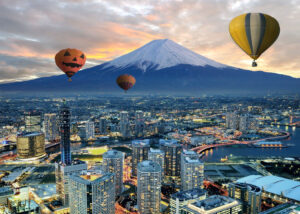
Tokyo’s Dazzling Skyline and Cultural Kaleidoscope
Tokyo, Japan’s bustling capital, is a city that pulsates with life, offering a dynamic blend of tradition and innovation. As you step into this metropolis, the first thing that captures your attention is the dazzling skyline adorned with towering structures like the iconic Tokyo Tower. The city’s modern architecture stands as a testament to Japan’s technological prowess, creating a striking contrast with the historic temples nestled amidst the urban sprawl.
Venturing into districts like Shibuya and Shinjuku, you’re greeted by a kaleidoscope of colors and sounds. Shibuya Crossing, often referred to as the busiest pedestrian crossing in the world, is a mesmerizing spectacle of organized chaos. Amidst the neon lights and giant screens, you’ll find yourself immersed in the energy of Tokyo’s vibrant street life. The sheer diversity of people, from locals in traditional yukata to fashion-forward youth, adds to the city’s captivating tapestry.
Akihabara’s Tech Wonderland and Unique Subcultures
For tech enthusiasts and anime lovers, Akihabara is a haven waiting to be explored. The labyrinthine streets of this district are adorned with neon signs, beckoning you into a world where cutting-edge technology and pop culture converge. Electronic shops showcase the latest gadgets, while anime stores offer a glimpse into Japan’s rich animation heritage.
Beyond the tech wonderland, Tokyo embraces unique subcultures. Harajuku, known for its avant-garde fashion and eccentric street styles, allows visitors to witness a fashion show on the streets itself. The district becomes a canvas where individuality and creativity paint the sidewalks. From Lolita fashion to punk-inspired looks, Harajuku showcases the diversity and freedom of expression thriving in Tokyo.
Culinary Delights and Hidden Gems
Tokyo isn’t just a feast for the eyes; it’s a culinary adventure waiting to be savored. From the lively stalls in Tsukiji Fish Market to the high-end dining experiences in Roppongi Hills, Tokyo caters to every palate. Delight your taste buds with sushi crafted by master chefs or indulge in a bowl of ramen at a cozy izakaya.
Venturing off the beaten path, you’ll discover hidden gems like Golden Gai, a historic nightlife area comprising tiny bars that often seat only a handful of patrons. Here, you can engage in conversations with locals and fellow travelers, creating memories that go beyond the typical tourist experience. Tokyo, with its energy and diversity, is a city that invites exploration and promises an unforgettable journey.
2. Kyoto – Where Time Stands Still
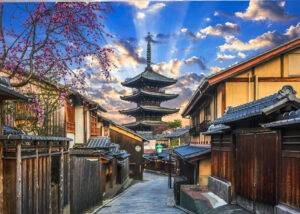
Gion’s Timeless Elegance and Geisha Traditions
Kyoto, a city steeped in history, invites visitors to take a step back in time. The Gion district, with its cobbled streets and traditional wooden machiya houses, exudes an air of timeless elegance. As you stroll through this historic neighborhood, you may catch a glimpse of geishas gracefully making their way to appointments, preserving an ancient tradition in a modern world.
The centerpiece of Kyoto’s cultural heritage is the Fushimi Inari Shrine, a Shinto sanctuary nestled at the base of a mountain. Ascending through thousands of vibrant torii gates, you embark on a spiritual journey surrounded by the serenity of the lush forest. Each gate, donated by individuals and businesses, creates a mesmerizing tunnel of crimson hues.
Tea Ceremonies and Tranquil Gardens
To truly immerse yourself in Kyoto’s cultural richness, partake in a traditional tea ceremony. The intricate choreography of the ceremony, from the preparation of matcha to the precise movements of the host, is a poetic expression of Japanese aesthetics. Teahouses within Kyoto offer an authentic experience, allowing you to savor the nuances of Japanese tea culture.
Amidst the city’s historical treasures, the Kinkaku-ji, or Golden Pavilion, stands as a gilded masterpiece reflected in the still waters of its surrounding pond. The Zen Buddhist temple, with its exquisite architecture and meticulously landscaped gardens, invites contemplation and reflection. Kyoto’s gardens, whether within temples or private residences, are tranquil havens that provide respite from the hustle of modern life.
Arashiyama’s Bamboo Grove and Nijo Castle
A visit to Kyoto is incomplete without exploring the enchanting Arashiyama district. The Bamboo Grove, with its towering bamboo stalks swaying in the breeze, creates an otherworldly atmosphere. The Togetsukyo Bridge and the Iwatayama Monkey Park add to the district’s allure, offering picturesque views and unique wildlife encounters.
Nijo Castle, another gem of Kyoto, transports visitors to the shogun era with its “nightingale floors” that chirp with every step. The castle’s Ninomaru Palace showcases exquisite paintings and intricate details, providing a glimpse into the opulence of Japan’s feudal past. Kyoto, where time stands still, invites travelers to immerse themselves in the beauty of its traditions and natural landscapes.
3. Mount Fuji – Japan’s Majestic Icon
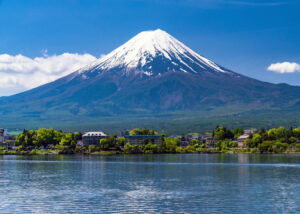
Gazing at the Symmetry of Mount Fuji
Mount Fuji, Japan’s majestic icon, stands as a beacon on the horizon, capturing the imagination of all who behold it. Its perfectly symmetrical cone, capped with a crown of snow, creates a picture-perfect landscape that has inspired artists and poets for centuries. Whether viewed from the bustling streets of Tokyo or the serene shores of the Fuji Five Lakes, the mountain’s presence is nothing short of awe-inspiring.
Embarking on a journey to Mount Fuji isn’t just about reaching its summit but about embracing the adventure along the way. Hiking trails wind through picturesque landscapes, offering panoramic views of the surrounding valleys and forests. As you ascend, the air becomes crisp, and the sense of accomplishment grows with each step, culminating in a breathtaking panorama from the summit.
Tranquil Reflections and Fuji Five Lakes
The Fuji Five Lakes, nestled at the base of the iconic volcano, offer a serene escape for those seeking tranquility amidst nature’s beauty. Each lake has its unique charm, reflecting the changing moods of Mount Fuji. Kawaguchiko, the most popular of the five, provides a postcard-worthy view of the mountain mirrored in its waters, creating a scene of unparalleled serenity.
Exploring the lakeside, visitors can indulge in a variety of activities, from leisurely boat rides to lakeside picnics. Hot springs in the area offer a chance to unwind and soak in the rejuvenating waters while enjoying uninterrupted views of Mount Fuji. The region’s beauty is not confined to a specific season, as each brings its own charm – cherry blossoms in spring, lush greenery in summer, fiery foliage in autumn, and the snow-capped landscape in winter.
Cultural Significance and Sacred Ascents
Mount Fuji isn’t merely a geographical wonder; it holds profound cultural significance for the Japanese people. Considered a sacred site, the mountain has been a source of inspiration for countless poems, paintings, and religious practices. The annual pilgrimage to its summit, known as the Fujiyoshida Fire Festival, is a testament to the enduring spiritual connection between the people and the mountain.
For those seeking a less strenuous encounter with Mount Fuji, the Chureito Pagoda offers a picturesque view framed by cherry blossoms in spring. The pagoda, perched on a hill, provides a stunning vantage point for capturing the beauty of Mount Fuji against the changing canvas of the sky. Whether you choose to conquer its heights or admire it from a distance, Mount Fuji’s allure lies not only in its physical grandeur but in the spiritual journey it represents.
A Timeless Symbol of Japan
Mount Fuji, with its symmetrical grace and cultural significance, stands as a timeless symbol of Japan’s natural beauty and spiritual depth. Whether you’re an intrepid hiker seeking adventure or a contemplative traveler yearning for a moment of serenity, the iconic volcano invites you to explore its slopes and appreciate the profound connection it shares with the heart and soul of Japan.
4. Hiroshima Peace Memorial Park – A Symbol of Resilience
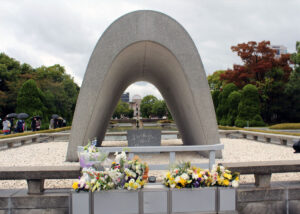
Remembrance Amidst Tranquil Gardens
In the heart of Hiroshima, where history met tragedy, the Hiroshima Peace Memorial Park stands as a poignant testament to resilience and hope. As you enter the park, you are greeted by serene gardens that surround the Atomic Bomb Dome, a skeletal structure frozen in time. The juxtaposition of nature’s tranquility and the remnants of the past creates an atmosphere of reflection and remembrance.
Wandering through the park, you encounter the Cenotaph for the A-bomb Victims, an arching monument that cradles the names of those who perished in the atomic bombing. The Peace Flame, kept ablaze since 1964, symbolizes the collective desire for a world free from nuclear weapons. These elements come together to form a harmonious space that encourages visitors to contemplate the consequences of war and the imperative of peace.
The Peace Memorial Museum – A Chronicle of Tragedy and Hope
At the heart of the park lies the Hiroshima Peace Memorial Museum, a poignant narrative that unfolds the events of August 6, 1945. The museum’s exhibits meticulously detail the impact of the atomic bomb on the city and its people, offering a sobering glimpse into the consequences of nuclear warfare. Personal testimonies, artifacts, and interactive displays provide a visceral experience that goes beyond textbooks, fostering a deeper understanding of the human cost of war.
The museum doesn’t merely dwell on the past but also serves as a beacon of hope, emphasizing the importance of global cooperation and disarmament. Exhibits showcase the city’s remarkable post-war recovery, highlighting Hiroshima’s commitment to peace education and its role in advocating for a world without nuclear weapons.
A Call for Global Harmony and Reflection
Hiroshima Peace Memorial Park is more than a memorial; it’s a call to action. The Children’s Peace Monument, adorned with origami cranes, pays tribute to Sadako Sasaki, a young victim of the atomic bomb. Her story, and the tradition of folding paper cranes for peace, echoes the universal desire for a future where such tragedies are relegated to history.
As you stand on the park’s grounds, you can’t help but be moved by the resilient spirit of the Hiroshima people. The city, once devastated, has emerged as a symbol of peace and reconciliation. Visitors leave with not only a somber appreciation of history but also a renewed commitment to fostering a world where the lessons of Hiroshima resonate in every corner.
From Tragedy to Triumph – Hiroshima’s Enduring Message
Hiroshima Peace Memorial Park stands as a living testament to the human spirit’s ability to rise from the ashes of tragedy. It urges us to reflect on the devastating consequences of war while inspiring a collective pursuit of peace. In this sacred space, amidst the gentle whispers of the wind and the rustle of leaves, visitors find not only a memorial but a profound call to forge a future where humanity embraces compassion and understanding.
5. Osaka – The Culinary Capital
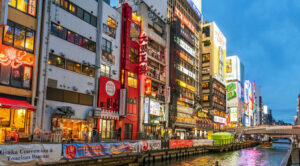
Dotonbori’s Gastronomic Extravaganza
Welcome to Osaka, the culinary heartbeat of Japan, where every street seems to whisper promises of delectable delights. At the heart of the gastronomic spectacle is Dotonbori, a district that serves as an open invitation to a feast for your taste buds. Neon lights illuminate the night as you stroll alongside the Dotonbori Canal, where an array of street food stalls and restaurants showcase Osaka’s culinary prowess.
Osaka’s culinary identity is deeply rooted in street food culture. Takoyaki, savory octopus balls, sizzle on griddles, emitting an irresistible aroma that beckons you to indulge. The district’s iconic neon sign, Glico Running Man, watches over the gastronomic revelry, silently endorsing the city’s status as a culinary capital.
Kitashinchi’s Culinary Elegance
For those seeking a more refined dining experience, Kitashinchi presents a sophisticated array of restaurants and bars. This district caters to food connoisseurs, offering a culinary journey through the diverse flavors of Japan. From kaiseki, a multi-course fine dining experience, to izakayas with their cozy ambiance, Kitashinchi paints a canvas of culinary elegance.
Osaka’s culinary scene is not merely about taste; it’s a celebration of creativity and presentation. Chefs in Kitashinchi transform local and seasonal ingredients into edible works of art. The city’s devotion to culinary craftsmanship is palpable, creating an atmosphere where every meal is an experience to savor.
Okonomiyaki and Culinary Adventures
No exploration of Osaka’s gastronomic wonders is complete without delving into the world of okonomiyaki. Often referred to as Japanese savory pancakes, okonomiyaki restaurants in districts like Namba invite you to participate in the culinary process. You can customize your pancake with various ingredients, showcasing the interactive and communal nature of Osaka’s food culture.
Beyond the traditional, Osaka embraces culinary adventures with unique offerings like fugu, the infamous blowfish known for its delicate yet potentially lethal flavors. Daring diners can experience the thrill of tasting this delicacy, expertly prepared by licensed chefs. Osaka’s culinary landscape is a dynamic blend of tradition and innovation, ensuring that every palate finds its perfect symphony of flavors.
Osaka’s Culinary Symphony
Osaka, with its bustling street food stalls and upscale dining establishments, is a city where culinary experiences transcend mere sustenance. It’s a symphony of flavors that resonate through the senses, leaving an indelible mark on every visitor. Whether you’re savoring takoyaki under the neon lights of Dotonbori or indulging in a refined kaiseki feast in Kitashinchi, Osaka invites you to join in its culinary celebration, where every bite tells a story of tradition, innovation, and the pure joy of good food.
6. Nara – Where Deer Roam Free
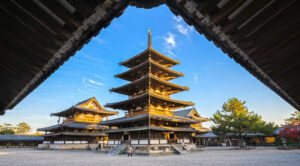
A Picturesque Stroll Through Nara Park
Nara, a city steeped in history and natural beauty, welcomes you with open arms and a unique charm – its friendly deer. As you enter Nara Park, you are immediately greeted by these gentle creatures, considered messengers of the gods in Japanese folklore. The park, spanning over 500 hectares, creates a picturesque setting where deer roam freely amidst historic temples and lush greenery.
Strolling through Nara Park is like stepping into a fairy tale. The Todai-ji Temple, a UNESCO World Heritage site, stands majestically, housing a colossal bronze Buddha within its ancient walls. The architecture, surrounded by the vibrant hues of seasonal blooms, creates a scene that encapsulates Nara’s blend of history and nature.
Interacting with Divine Messengers
One of Nara’s unique experiences is the opportunity to interact with the deer that roam the park. Considered sacred, these friendly animals bow to visitors when offered special deer crackers, locally known as “shika senbei.” The sight of deer freely wandering, occasionally stopping for a playful interaction, adds a touch of whimsy to the historic ambiance.
While exploring Nara Park, you may encounter deer gracefully meandering through the grounds of Kasuga Taisha Shrine, another gem within the park. The shrine’s vermilion lanterns and moss-covered stone lanterns create a mystical atmosphere, inviting you to delve deeper into Nara’s spiritual and natural wonders.
Nara’s Tranquil Beauty Beyond the Park
Beyond the bustling activity of Nara Park, the city unfolds with tranquil streets and hidden gems. Yoshiki-en Garden, a traditional Japanese garden, invites visitors to unwind amidst meticulously landscaped grounds. The Isuien Garden, featuring a central pond and teahouse, offers a serene escape from the modern world.
Nara’s charm extends to its vibrant local markets, where you can savor regional delights like kakinoha sushi and pick up traditional crafts as souvenirs. The city’s historic districts, such as Naramachi, with its well-preserved machiya houses, provide a glimpse into the daily life of Nara’s past.
Nara’s Harmony of Nature and History
Nara, with its free-roaming deer and harmonious blend of nature and history, is a city that captivates the soul. It invites you to embrace the tranquility of its parks, witness the grandeur of its temples, and savor the simplicity of life within its historic districts. Nara’s beauty lies not just in its landmarks but in the seamless harmony between its residents, whether two-legged or four-legged, and the enchanting surroundings that make this city a truly special destination.
7. Hakone – Relaxation in Nature’s Embrace
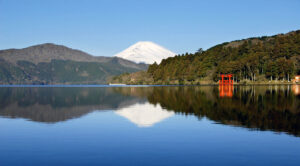
Soaking in the Beauty of Hakone
Nestled in the embrace of the Fuji-Hakone-Izu National Park, Hakone offers a serene retreat where relaxation and nature intertwine. The moment you set foot in this charming town, you’re greeted by the soothing melodies of flowing rivers and the gentle rustling of leaves. Hakone’s appeal lies in its ability to transport you from the bustling metropolis to a haven of tranquility.
The iconic Mount Fuji watches over Hakone, creating a mesmerizing backdrop for the town’s many attractions. Onsen resorts, known for their therapeutic hot springs, dot the landscape, inviting visitors to unwind in nature’s warm embrace. Hakone is not just a destination; it’s a therapeutic journey for both the body and the soul.
Open-Air Art and Cultural Elegance
Hakone is not only a sanctuary for relaxation but also a haven for art enthusiasts. The Hakone Open Air Museum, a unique fusion of art and nature, showcases sculptures against the backdrop of lush greenery and the distant mountains. Visitors can wander through the beautifully landscaped grounds, engaging with art in a setting that transcends traditional gallery spaces.
Beyond the art scene, Hakone’s cultural richness is evident in attractions like the Hakone Shrine and the Hakone Pirate Ship. The shrine, surrounded by towering cedar trees, exudes an air of mysticism, while the pirate ship cruise on Lake Ashi provides a scenic journey with panoramic views of the surrounding mountains and the iconic Torii Gate at the lake’s edge.
A Journey Through Hakone’s Senses
Hakone invites you to indulge your senses in every possible way. The Hakone Venetian Glass Museum, with its dazzling array of glasswork, appeals to your visual senses. The aroma of sulfur wafting from the hot springs engages your olfactory senses, creating an immersive experience that goes beyond the ordinary.
Exploring Hakone’s diverse landscapes is like flipping through the pages of a storybook. Hakone’s cedar-lined paths lead to hidden waterfalls, tranquil lakes, and ancient cedar groves. Owakudani, a volcanic valley with hot springs and fumaroles, offers a unique chance to witness the Earth’s raw power in a surreal, otherworldly setting.
Hakone’s Symphony of Nature and Culture
Hakone, with its natural beauty and cultural richness, orchestrates a symphony that resonates through every visitor’s heart. It’s a town where art and nature dance together, where hot springs rejuvenate both body and soul, and where the majestic Mount Fuji stands as a silent guardian over the scenic landscapes. Hakone beckons you to immerse yourself in its sensory journey, promising an escape from the ordinary into a world of unparalleled beauty and tranquility.
8. Himeji Castle – A Fortress of Elegance
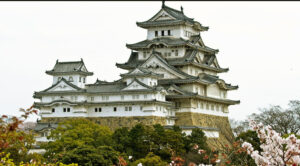
The White Heron’s Majestic Perch
As you approach Himeji Castle, also known as the White Heron Castle, its pristine white facade rises against the backdrop of the clear blue sky, creating a sight that is both imposing and elegant. Located in the heart of Himeji city, this fortress is a beacon of Japan’s feudal history, standing tall as one of the country’s most iconic and well-preserved castles.
The castle’s intricate defensive features, including imposing walls and strategically placed loopholes, tell tales of a bygone era. The elegant architecture, resembling a graceful bird in flight, earned Himeji Castle its nickname, and as you ascend its many levels, you can’t help but feel transported to a time when samurai warriors roamed its halls.
A Stroll Through History
Walking through the sprawling castle grounds, you’ll find yourself immersed in the rich history of Himeji. The Ninomaru Palace, adorned with beautiful gardens and ornate decorations, offers a glimpse into the opulent lifestyle of the ruling class. The castle’s defensive structures, such as the maze-like maze of gates and baileys, provide insights into the strategic brilliance of its architects.
The view from the topmost floor of the main keep is nothing short of spectacular. As you gaze over the cityscape, you’ll appreciate the strategic location chosen for Himeji Castle, offering panoramic views of the surrounding landscapes. Every nook and cranny of this fortress seems to whisper tales of battles, political intrigue, and the resilience of a nation’s heritage.
Cherry Blossoms and Nighttime Illumination
Himeji Castle transforms with the changing seasons, becoming a canvas for nature’s beauty. In spring, cherry blossoms envelop the castle in a delicate pink embrace, creating a scene straight out of a dream. The juxtaposition of the white fortress against the ephemeral blooms is a sight that draws visitors from near and far.
During the evening, the castle undergoes a magical transformation with nighttime illumination. The warm glow accentuates the architectural details, casting a romantic ambiance over the entire complex. As you wander through the illuminated grounds, you’ll find yourself enchanted by the timeless allure of Himeji Castle.
Himeji Castle’s Enduring Legacy
Himeji Castle stands not just as a historical relic but as a living testament to Japan’s architectural and cultural legacy. Its elegant facade, strategic design, and timeless beauty make it a must-visit destination for history enthusiasts and casual travelers alike. Himeji Castle, with its ethereal charm, invites you to step into a world where the past and present seamlessly converge, offering a glimpse into the heart of Japan’s feudal history.
9. Nikko – Where Nature Meets Artistry
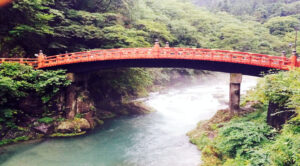
Toshogu Shrine – A Masterpiece of Carved Splendor
Nikko, a UNESCO World Heritage site nestled amidst the mountains, welcomes you with open arms and invites you into a realm where nature and artistry coalesce seamlessly. At the heart of this enchanting destination lies the Toshogu Shrine, a complex adorned with intricate carvings, vibrant colors, and a sense of spiritual grandeur. Dedicated to Tokugawa Ieyasu, the founder of the Tokugawa shogunate, Toshogu is a masterpiece that stands as a testament to Japan’s rich artistic heritage.
The Yomeimon Gate, often referred to as the “Gate of the Setting Sun,” is a portal into a world where mythical creatures, deities, and historical figures come to life through meticulously carved details. Each step within the shrine’s precincts is a journey through time, as you encounter the serene beauty of the sacred Karamon Gate and the majesty of the five-story pagoda.
Enchanting Surroundings – Kegon Falls and Lake Chuzenji
Beyond the cultural richness of Toshogu Shrine, Nikko beckons with its natural wonders. The Kegon Falls, cascading from a height of 97 meters, creates a mesmerizing spectacle that captivates the senses. A visit to the falls allows you to immerse yourself in the raw power and beauty of Japan’s untamed landscapes.
Lake Chuzenji, surrounded by dense forests and rolling hills, offers a serene retreat for those seeking tranquility. The picturesque lake, formed by volcanic activity, provides a breathtaking backdrop for boat rides or leisurely strolls along its shores. As the seasons change, so does the scenery, painting a canvas of vibrant hues in autumn and offering a blanket of serenity in winter.
Spiritual Harmony at Futarasan Shrine and Shinkyo Bridge
Nikko’s spiritual harmony extends to the Futarasan Shrine, located amidst the verdant forests surrounding Lake Chuzenji. Dedicated to the deities of Nikko’s sacred mountains, Futarasan Shrine harmonizes seamlessly with the natural environment, creating a sense of oneness with the landscape. The shrine’s Shinkyo Bridge, spanning the Daiya River, adds to the ethereal ambiance, symbolizing the transition from the mundane to the sacred.
Nikko, with its fusion of artistic brilliance and natural splendor, invites you to explore a world where cultural treasures and breathtaking landscapes coexist in perfect harmony. Whether you’re captivated by the detailed carvings of Toshogu Shrine, mesmerized by the waterfalls and lakes, or immersed in the spiritual tranquility of Futarasan Shrine, Nikko offers an enriching experience that transcends the ordinary.
Nikko’s Tapestry – A Testament to Japan’s Beauty
Nikko, with its cultural treasures and natural wonders, weaves a tapestry that reflects the multifaceted beauty of Japan. It is a destination where artistry and nature dance together, creating an enchanting symphony that resonates with every visitor. Nikko invites you to step into its embrace, where every temple, waterfall, and lake tells a story of Japan’s rich heritage and the enduring allure of its landscapes.
10. Kanazawa – The City of Gold Leaf Elegance
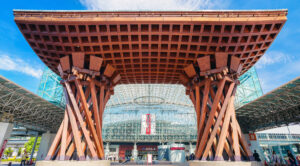
Kanazawa’s Gilded Legacy
Welcome to Kanazawa, a city where tradition and innovation intertwine to create a captivating tapestry of elegance. Known as the “City of Gold Leaf,” Kanazawa boasts a rich history of craftsmanship, particularly in the art of decorating with gold leaf. The streets are adorned with the sparkle of gold, transforming the city into a living canvas of opulence and refined taste.
Walking through the historic districts of Higashi-Chaya and Nagamachi, you’ll witness the legacy of Kanazawa’s gilded heritage. Tea houses and merchant houses, their exteriors glistening with gold leaf, offer a glimpse into the city’s artistic prowess. The delicate balance between the historic charm and modern vibrancy makes Kanazawa a destination where every corner exudes a sense of timeless beauty.
Kenrokuen Garden – Nature’s Masterpiece
At the heart of Kanazawa lies Kenrokuen, one of Japan’s three most beautiful gardens. Kenrokuen, translating to “Garden of the Six Sublimities,” showcases the meticulous artistry of landscape design. As you stroll through the garden, you’ll encounter perfectly manicured lawns, serene ponds, and seasonal blooms that create a harmonious symphony of colors and textures.
Kenrokuen’s iconic Kotoji Toro, a stone lantern with two legs resembling the bridge of a koto, adds a touch of cultural significance to the landscape. The garden transforms with the seasons, from cherry blossoms in spring to the vibrant hues of maple leaves in autumn, offering a visual feast that complements Kanazawa’s reputation for refined aesthetics.
Nomura Samurai House – A Glimpse into Edo-era Elegance
For a glimpse into Kanazawa’s samurai heritage, a visit to the Nomura Samurai House is a must. This well-preserved residence provides an intimate look into the daily lives of samurai during the Edo period. The house’s sliding doors, adorned with gold leaf and intricate woodwork, showcase the city’s dedication to preserving its cultural legacy.
Kanazawa’s dedication to traditional arts is further exemplified by the Hakuza Honten, a shop specializing in gold leaf products. From delicate crafts to edible gold-covered treats, the shop allows visitors to take a piece of Kanazawa’s gilded elegance home. The artistry of gold leaf extends beyond decoration to become an integral part of the city’s identity.
Kanazawa’s Timeless Allure
Kanazawa, with its gilded streets, exquisite gardens, and well-preserved heritage, stands as a testament to Japan’s commitment to preserving its cultural treasures. It is a city where the elegance of gold leaf seamlessly blends with the beauty of nature and the grace of historical architecture. Kanazawa invites you to wander through its streets, where every glimmer of gold reflects the enduring legacy of a city that has mastered the art of timeless allure.
11. Nagasaki – A Tapestry of Resilience and Harmony

Nagasaki’s Tranquil Harbor and Glimpses of History
Nagasaki, a city nestled within the embrace of Kyushu’s coast, invites you to explore a tapestry woven with threads of resilience and cultural harmony. The tranquil harbor, once a gateway to international trade, now serves as a testament to Nagasaki’s ability to rise from the ashes of history. As you gaze upon the serene waters, it’s hard to fathom that this peaceful scene was once a stage for historic encounters and profound challenges.
The city’s historical richness unfolds as you wander through Glover Garden, where Western-style residences from the Meiji era stand as silent witnesses to Nagasaki’s unique past. The Oura Church, Japan’s oldest Christian church, adds another layer to the city’s cultural diversity. Nagasaki’s ability to preserve and showcase its history allows visitors to step into the footsteps of those who walked its streets centuries ago.
Peace Park – A Symbol of Healing and Hope
Nagasaki’s Peace Park stands as a solemn reminder of the city’s resilience in the face of tragedy. Ground zero of the atomic bomb explosion in 1945, the park now exudes a sense of tranquility and hope. The Peace Statue, with its outstretched arms and a face both pained and determined, embodies the city’s commitment to a world free from nuclear devastation.
Walking through the park, you’ll encounter monuments dedicated to the memory of those who perished in the atomic bombing. The Hypocenter Cenotaph, marking the precise point of the blast, and the Fountain of Peace, a symbol of healing, evoke deep emotions. Nagasaki’s Peace Park is not just a place of remembrance but a call for global harmony and the pursuit of a future free from nuclear threats.
Nagasaki’s Unique Cultural Fusion
Nagasaki’s history as a trading port has left an indelible mark on its cultural fabric. Dejima, an artificial island in Nagasaki Bay, was once a Dutch trading post and the only window to the world during Japan’s period of isolation. The Nagasaki Museum of History and Culture provides a captivating journey through the city’s diverse heritage, showcasing Chinese, Portuguese, and Dutch influences.
The Shinto Nagasaki Kunchi Festival, a vibrant celebration held in autumn, reflects the city’s multicultural roots. Traditional dances, elaborate costumes, and lively music create a kaleidoscope of cultural richness. Nagasaki’s ability to embrace and celebrate its diverse influences is a testament to the city’s enduring spirit of harmony.
Nagasaki’s Ongoing Journey of Resilience
Nagasaki, with its tranquil harbor, poignant memorials, and vibrant cultural fusion, is a city that has transformed tragedy into a beacon of hope. It is a destination where history is not merely preserved but woven into the city’s vibrant present. Nagasaki invites you to explore its streets, where every step tells a story of resilience, cultural harmony, and the unwavering pursuit of peace.
12. Kyoto – Timeless Beauty Amidst Temples and Gardens
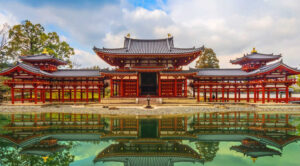
Kyoto’s Timeless Charm
Step into Kyoto, a city where time seems to slow down, allowing you to immerse yourself in the elegance of ancient Japan. Kyoto’s timeless charm lies in its ability to preserve centuries-old traditions amidst the hustle and bustle of modern life. As you wander through its streets, lined with traditional machiya houses and wooden teahouses, you’ll find yourself transported to a bygone era where every corner exudes a sense of refined beauty.
The city’s commitment to preserving its cultural heritage is evident in its well-preserved temples and shrines, each a testament to Kyoto’s enduring grace. Kyoto invites you to be a part of its living history, where the whispers of the past echo through the cobblestone streets and the rustling leaves of meticulously manicured gardens.
Kinkaku-ji – The Golden Pavilion’s Radiance
Kinkaku-ji, or the Golden Pavilion, stands as an iconic symbol of Kyoto’s architectural brilliance. The shimmering gold leaf exterior reflects in the still waters of the surrounding pond, creating a scene of ethereal beauty. The Zen Buddhist temple, once the retirement villa of shogun Ashikaga Yoshimitsu, has become a pilgrimage site for those seeking tranquility and a glimpse into Kyoto’s artistic legacy.
Wandering through the temple’s meticulously landscaped gardens, you’ll find a harmony of elements – from the lush greenery to the delicate cherry blossoms. The serenity of Kinkaku-ji extends beyond its visual splendor, offering visitors a moment of contemplation and connection with nature.
Gion District – Geisha Grace and Hanami Delights
No exploration of Kyoto is complete without a visit to the Gion district, a realm where geisha culture thrives amidst traditional wooden machiya houses. As dusk falls, the lantern-lit streets come alive with the graceful presence of geisha and maiko, their intricate kimonos and traditional hairstyles adding to the district’s enchanting ambiance.
During cherry blossom season, Gion becomes a canvas of pink hues as hanami, or flower viewing, takes center stage. The district’s Yasaka Shrine, surrounded by cherry blossoms in full bloom, provides a magical setting for celebrating the fleeting beauty of spring. Kyoto’s Gion district, with its blend of cultural richness and seasonal delights, captures the essence of the city’s enduring allure.
Kyoto’s Enduring Allure
Kyoto, with its timeless temples, traditional districts, and serene gardens, is a city that invites you to step into a world where past and present seamlessly coexist. It is a destination where every stone pathway tells a story, and every garden bloom reflects the changing seasons. Kyoto’s enduring allure lies in its ability to transcend time, offering visitors a glimpse into the heart and soul of Japan’s cultural legacy.
13. Fushimi Inari Taisha – The Enchanting Gates of Kyoto
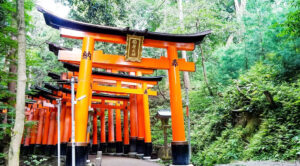
A Thousand Torii Gates Beckon
In the southern reaches of Kyoto, a mystical journey awaits at Fushimi Inari Taisha, a Shinto shrine renowned for its mesmerizing pathway lined with thousands of vibrant torii gates. As you enter through the main gate, known as the Romon, you’re immediately transported into a world where the sacred and the surreal coalesce. The crimson torii gates, adorned with black characters, create a visual spectacle that captures the essence of Fushimi Inari Taisha’s enchantment.
Ascending the mountain along the Senbon Torii (Thousand Torii) path, each gate serves as a dedication to the Shinto god of rice and prosperity, Inari. The interplay of light and shadow through the gates, combined with the gentle rustling of leaves, creates an otherworldly atmosphere that beckons you to explore the secrets hidden within.
Fox Statues and Spiritual Tranquility
Fox statues, known as “kitsune,” guard the pathways of Fushimi Inari Taisha, their mischievous expressions adding a touch of whimsy to the spiritual journey. In Shinto belief, foxes are considered messengers of Inari, and the stone guardians scattered throughout the shrine’s grounds emphasize the spiritual connection between the earthly and divine.
As you ascend the mountain, passing through the dense forest, a sense of tranquility envelops you. Fushimi Inari Taisha provides moments for introspection, with stone shrines and smaller torii gates along the way offering secluded spaces for reflection. The harmony of nature and spirituality intertwines seamlessly, creating an experience that transcends the physical climb.
Reaching the Summit and the View Beyond
Reaching the summit of Mount Inari is not just a physical accomplishment but a journey of spiritual significance. The panoramic view of Kyoto from the mountain’s peak is a breathtaking reward for your ascent. The city unfolds beneath you like a tapestry, and as the sun sets, casting a warm glow over the landscape, you’ll find yourself captivated by the sheer beauty that stretches as far as the eye can see.
Descending from the summit, you’re surrounded by the diminishing light, and the torii gates seem to glow in the twilight. The return journey, amidst the soft illumination, offers a different perspective, casting a serene and contemplative mood over the already enchanting shrine. Fushimi Inari Taisha, with its mystical ambiance and awe-inspiring views, leaves an indelible mark on every visitor.
Fushimi Inari Taisha – A Gateway to the Divine
Fushimi Inari Taisha, with its thousand torii gates and spiritual ambiance, stands as a gateway between the earthly and divine realms. It invites you to embark on a journey where the vibrant hues of the gates, the playful presence of fox guardians, and the tranquil ascent up Mount Inari weave together a narrative of sacred beauty. Kyoto’s enchanting shrine is not just a destination; it’s an immersive experience that invites you to explore the mystical connections between nature, spirituality, and the enduring allure of Fushimi Inari Taisha.
14. Arashiyama – Nature’s Symphony in Kyoto
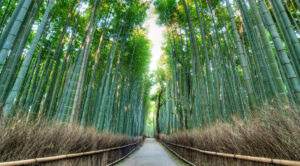
The Bamboo Grove’s Whispers
Nestled on the western outskirts of Kyoto, Arashiyama invites you to step into a natural wonderland where bamboo stands tall, creating a symphony of rustling leaves. The Arashiyama Bamboo Grove, a mystical path flanked by towering bamboo shoots, transports you to a world where the air is filled with a gentle rhythm, and sunlight filters through the dense canopy above.
As you meander through this enchanting bamboo forest, you’ll find hidden pathways leading to secluded glades and traditional temples. The Bamboo Grove’s whispers become a backdrop to the serenity that permeates Arashiyama, inviting you to lose yourself in the tranquil beauty that surrounds you.
Togetsukyo Bridge – A Tranquil Crossing
Arashiyama’s allure extends beyond the bamboo haven to the elegant Togetsukyo Bridge, which spans the Hozu River. The name “Togetsukyo” translates to “Moon Crossing,” a poetic moniker that evokes the bridge’s reflection in the water as it arcs gracefully across the river. The bridge, framed by the changing seasons, creates a serene tableau that encapsulates the timeless beauty of Kyoto.
From the bridge, the Arashiyama hills unfold in a panorama of rich greens and vibrant hues, reflecting the seasonal tapestry of cherry blossoms in spring and fiery foliage in autumn. As you traverse Togetsukyo, the gentle river breeze carries with it a sense of tranquility, inviting you to pause and absorb the beauty of nature’s canvas.
Iwatayama Monkey Park – A Playful Haven
Beyond the Bamboo Grove and Togetsukyo, Arashiyama offers a whimsical escape at the Iwatayama Monkey Park. Here, macaques roam freely in a natural habitat, offering visitors a chance to observe these playful creatures in their element. The panoramic views of Kyoto from the park’s summit provide a stunning backdrop to the charming antics of the resident monkeys.
A short hike through the lush forest brings you to the park’s summit, where you can interact with the monkeys and enjoy a serene vista of Kyoto’s rooftops and hills. The playful energy of the monkeys and the tranquil setting create a unique blend of excitement and peace, making the Iwatayama Monkey Park a delightful stop in your Arashiyama adventure.
Arashiyama’s Timeless Harmony
Arashiyama, with its Bamboo Grove, Togetsukyo Bridge, and Monkey Park, is a testament to the timeless harmony between nature and human artistry. It beckons you to wander through its bamboo-clad paths, cross the serene bridge, and share moments of playfulness with the resident monkeys. Kyoto’s Arashiyama is not just a destination; it’s a symphony of natural wonders that invites you to immerse yourself in the soothing melodies of bamboo whispers, river crossings, and playful monkey chatter.
15. Hiroshima – Resilience and Peace Blossoms
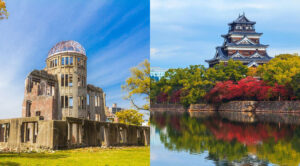
Peace Memorial Park – A Haven of Reflection
Hiroshima, a city etched in history, stands as a poignant symbol of resilience and hope. At the heart of Hiroshima lies the Peace Memorial Park, a haven dedicated to the memory of the atomic bombing in 1945. The park, with its tranquil ponds, blooming cherry trees, and the iconic A-Bomb Dome, is a place of quiet reflection and a testament to the city’s unwavering commitment to peace.
As you stroll through the park, the Cenotaph for the A-Bomb Victims draws your attention. Inscribed with the plea, “Let all the souls here rest in peace, for we shall not repeat the evil,” it serves as a powerful reminder of the city’s determination to ensure that the horrors of war are never forgotten. The Peace Flame, kept alight since 1964, symbolizes the city’s dedication to a world free from nuclear weapons.
Hiroshima Castle – A Phoenix Rising
Hiroshima Castle, though reconstructed after the bombing, stands as a resilient testament to the city’s enduring spirit. The castle, with its elegant white facade and distinctive red roof, offers a glimpse into Hiroshima’s feudal history. As you ascend the castle’s wooden keep, panoramic views of the city and the surrounding landscape unfold, providing a sense of Hiroshima’s transformation and rebirth.
Surrounding the castle is Shukkeien Garden, a traditional Japanese landscape garden that complements the castle’s elegance. The garden, with its teahouses, bridges, and koi ponds, invites visitors to find solace in nature and experience the peaceful coexistence between man-made beauty and the resilience of the natural world.
Mazda Museum – Innovation and Harmony
In the heart of Hiroshima lies the Mazda Museum, a celebration of innovation and harmony between industry and nature. The museum offers a fascinating journey through the history of Mazda, showcasing the evolution of the automobile industry. The juxtaposition of sleek modern designs against the backdrop of Hiroshima’s historical landscape is a testament to the city’s ability to embrace progress while honoring its past.
The Mazda Museum’s commitment to sustainability and environmental consciousness aligns with Hiroshima’s broader message of harmony and peace. The museum’s exhibits highlight Mazda’s efforts in developing eco-friendly technologies, underlining the city’s dedication to a future that respects both nature and innovation.
Hiroshima’s Blooming Resilience
Hiroshima, with its Peace Memorial Park, reconstructed castle, and innovative museum, is a city where resilience blooms alongside cherry blossoms. It stands as a living testament to the indomitable spirit of its residents, who have transformed tragedy into a commitment to peace and progress. Hiroshima invites you to witness its journey, where the echoes of the past harmonize with the blossoming present, creating a cityscape that speaks to the enduring power of hope and the pursuit of a brighter future.
Conclusion: Japan’s Tapestry of Wonders
Embarking on a journey through Japan’s top-rated tourist attractions is like unraveling a vibrant tapestry, each destination a unique thread contributing to the country’s rich cultural landscape. From the historic temples of Kyoto to the resilient spirit of Hiroshima, Japan beckons travelers with a symphony of experiences that resonate with history, nature, and innovation.
As you traverse the bustling streets of Tokyo, stand before the iconic Mount Fuji, and wander through the enchanting bamboo groves of Arashiyama, you’ll find yourself immersed in a narrative that transcends time. Japan’s blend of traditional elegance and modern vibrancy creates a harmonious dance that captivates the senses and leaves an indelible mark on the soul.
Whether you’re exploring the cultural fusion of Kanazawa, communing with deer in Nara, or basking in the elegance of Himeji Castle, each destination weaves its own chapter into Japan’s compelling story. The country’s commitment to preserving its heritage, embracing innovation, and promoting peace is evident at every turn, making each visit not just a vacation but a cultural odyssey.
As you savor the flavors of local cuisine, immerse yourself in the tranquility of Japanese gardens, and witness the resilience of cities like Hiroshima, you become a part of Japan’s intricate tapestry. The Land of the Rising Sun invites you to explore its wonders, engage with its people, and discover the boundless beauty that unfolds in every corner.
Japan’s top-rated tourist attractions are not mere destinations; they are windows into a world where tradition and modernity coalesce, nature and architecture harmonize, and the past and future intertwine. The journey through these enchanting places is a celebration of Japan’s perplexing diversity, bursting with tales of history, adorned with the beauty of nature, and pulsating with the vibrant energy of contemporary life.
So, whether you’re drawn to the serene temples of Kyoto, the bustling streets of Tokyo, or the resilient spirit of Hiroshima, Japan’s tapestry of wonders awaits, ready to embrace you in an unforgettable adventure where every moment is a brushstroke in the masterpiece of your own travel story.
Frequently Asked Questions:
- Q: What is the best time to visit Japan for cherry blossoms?
- A: The best time to witness cherry blossoms in Japan is typically during spring, usually from late March to early April.
- Q: Are deer in Nara dangerous?
- A: While the deer in Nara are generally friendly, it’s important to be cautious and respectful. They may bow for deer crackers, but avoid provoking or feeding them too much.
- Q: Can you climb Mount Fuji?
- A: Yes, Mount Fuji is a popular climbing destination during the official climbing season from early July to early September.
- Q: What is the significance of the torii gates in Fushimi Inari Taisha?
- A: The torii gates at Fushimi Inari Taisha symbolize the transition from the ordinary to the sacred. Each gate is a dedication to Inari, the Shinto god of rice and prosperity.
- Q: How can I contribute to peace in Hiroshima?
- A: Visitors can contribute to peace by respecting the solemnity of Peace Memorial Park, learning about Hiroshima’s history, and supporting local initiatives promoting peace and reconciliation.
Japan, with its diverse attractions, welcomes you to explore its wonders, ensuring that each visit is a unique chapter in your personal journey through this captivating and multifaceted land.
